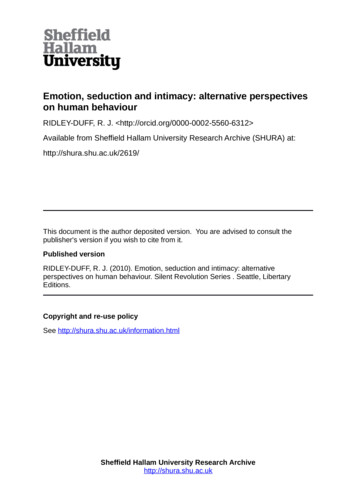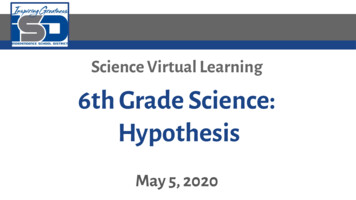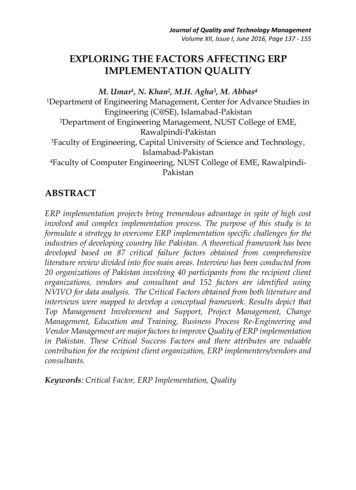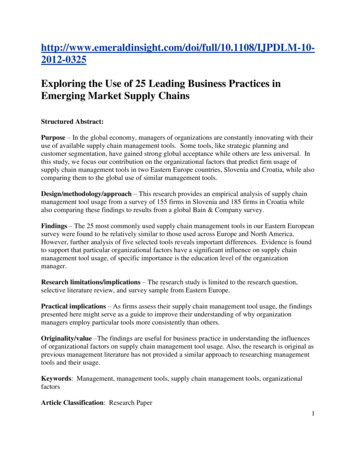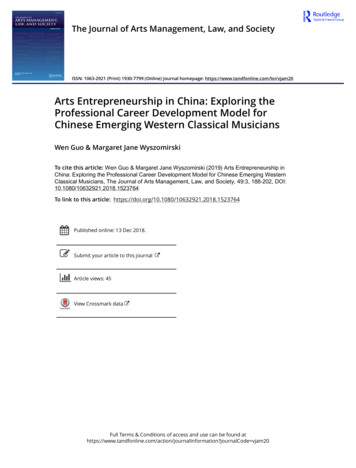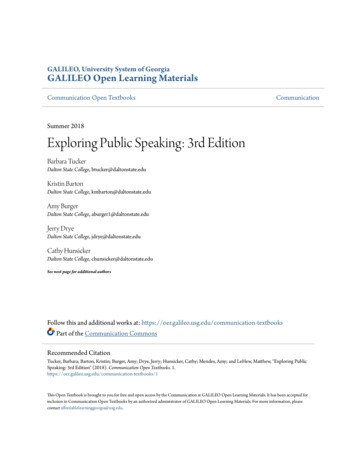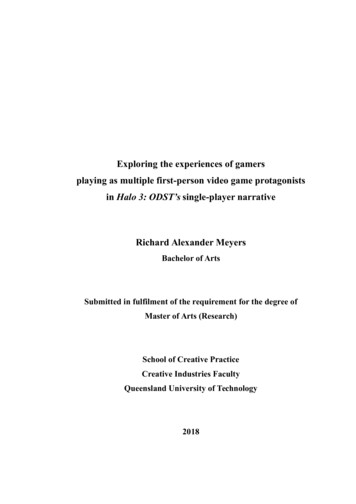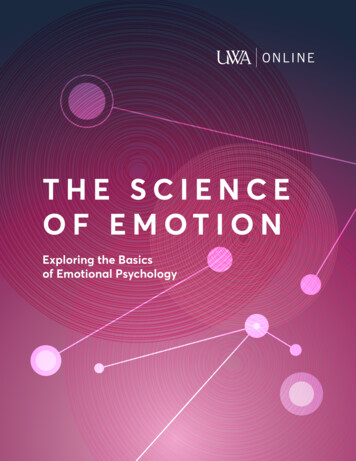
Transcription
THE SCIENCEOF EMOTIONExploring the Basicsof Emotional Psychology
INTRODUCTIONHow we interpret and respond to the world aroundus makes up who we are and contributes to ourquality of life. The study of emotional psychologyallows researchers to dive into what makes humansreact as they do to certain stimuli and how thosereactions affect us both physically and mentally.While the study of emotional psychology is vastand complex, researchers have discovered quite abit about what constitutes our emotions and ourbehavioral and physical reactions to them.2
TA B L E O F C O N T E N T SD E F I N I N G E M OT I O N S . . . . . . . . . . . . . .4T H E P RO C E S S O F E M OT I O N . . . . . . . . . . .5Subjective Experiences . . . . . . . . . . . . . . . . . . . . . . . . 5Physiological Responses . . . . . . . . . . . . . . . . . . . . . . . 6Behavioral Responses . . . . . . . . . . . . . . . . . . . . . . . . . 6E M OT I O N S A N D P SYC H O LO GY . . . . . . . . . . 8Basic and Complex Emotions . . . . . . . . . . . . . . . . . . . . . 8T H EO R I E S O F E M OT I O N . . . . . . . . . . . . .11James-Lange Theory . . . . . . . . . . . . . . . . . . . . . . . . . 11Facial-Feedback Theory . . . . . . . . . . . . . . . . . . . . . . . 12Cannon-Bard Theory . . . . . . . . . . . . . . . . . . . . . . . . .12Schachter-Singer Theory . . . . . . . . . . . . . . . . . . . . . . . 13Cognitive Appraisal Theory . . . . . . . . . . . . . . . . . . . . . . 13B E N E F I T S O F U N D E R STA N D I N G E M OT I O N S . . . 14T H E F U T U R E O F E M OT I O N A L P SYC H O LO GY . . . 173
D E F I N I N G E M OT I O N SEmotions are often confused with feelings and moods, but thethree terms are not interchangeable. According to the AmericanPsychological Association (APA), emotion is defined as “a complexreaction pattern, involving experiential, behavioral and physiologicalelements.” Emotions are how individuals deal with matters orsituations they find personally significant. Emotional experienceshave three components: a subjective experience, a physiologicalresponse and a behavioral or expressive response.Feelings arise from an emotional experience. Because a person isconscious of the experience, this is classified in the same categoryas hunger or pain. A feeling is the result of an emotion and may beinfluenced by memories, beliefs and other factors.A mood is described by the APA as “any short-lived emotional state,usually of low intensity.” Moods differ from emotions because theylack stimuli and have no clear starting point. For example, insults cantrigger the emotion of anger while an angry mood may arise withoutapparent cause.Defining emotions is a task that is not yet complete. Many researchersare still proposing theories about what makes up our emotions, andexisting theories are constantly being challenged. Still, there’s a goodbasis of knowledge to analyze when exploring the topic.4
T H E P RO C E S S O F E M OT I O NWhile there is debate about sequence, there is general agreement thatemotions, as mentioned earlier, are made up of three parts: subjectiveexperiences, physiological responses and behavioral responses. Let’slook at each of these parts in more detail.Subjective ExperiencesAll emotions begin with a subjective experience, also referred toas a stimulus, but what does that mean? While basic emotions areexpressed by all individuals regardless of culture or upbringing, theexperience that produces them can he highly subjective.Subjective experiences can range from something as simple as seeinga color to something as major as losing a loved one or getting married.No matter how intense the experience is, it can provoke many emotionsin a single individual and the emotions each individual feel may bedifferent. For example, one person may feel anger and regret at theloss of a loved one while another may experience intense sadness.5
Physiological ResponsesWe all know how it feels to have our heart beat fast with fear. Thisphysiological response is the result of the autonomic nervous system’sreaction to the emotion we’re experiencing. The autonomic nervoussystem controls our involuntary bodily responses and regulates ourfight-or-flight response. According to many psychologists, ourphysiological responses are likely how emotion helped us evolve andsurvive as humans throughout history.Interestingly, studies have shown autonomic physiological responsesare strongest when a person’s facial expressions most closely resemblethe expression of the emotion they’re experiencing. In other words,facial expressions play an important role in responding accordingly toan emotion in a physical sense.Behavioral ResponsesThe behavioral response aspect of the emotional response is theactual expression of the emotion. Behavioral responses can include asmile, a grimace, a laugh or a sigh, along with many other reactionsdepending on societal norms and personality.While plentiful research suggests that many facial expressions areuniversal, such as a frown to indicate sadness, sociocultural normsand individual upbringings play a role in our behavioral responses.For example, how love is expressed is different both from person toperson and across cultures.6
Behavioral responses are important to signal to others how we’refeeling, but research shows that they’re also vital to individuals’well-being. A study in the Journal of Abnormal Psychology found thatwhile watching negative and positive emotional films, suppressionof behavioral responses to emotion had physical effects on theparticipants. The effects included elevated heart rates. This suggeststhat expressing behavioral responses to stimuli, both positive andnegative, is better for your overall health than holding those responsesinside. Thus, there are benefits of smiling, laughing and expressingnegative emotions in a healthy way.The physiological and behavioral responses associated with emotionsillustrate that emotion is much more than a mental state. Emotionaffects our whole demeanor and our health. Furthermore, our abilityto understand others’ behavioral responses plays a huge role in ouremotional intelligence, which will be discussed in more detail later.7
E M OT I O N S A N D P SYC H O LO GYTheories and hypotheses about emotions date back centuries. In fact,basic or primary emotions are referenced in the Book of Rights, a firstcentury Chinese encyclopedia. Emotion is much harder to measure andproperly define than many other human responses. Much of the studythat has been done in emotional psychology is about basic emotions,our psychological and behavioral responses, and the role of emotionalintelligence in our lives.Basic and Complex EmotionsIn emotional psychology, emotions are split into two groups: basicand complex.Basic emotions are associated with recognizable facial expressionsand tend to happen automatically. Charles Darwin was the first tosuggest that emotion-induced facial expressions are universal. Thissuggestion was a centerpiece idea to his theory of evolution, implyingthat emotions and their expressions were biological and adaptive.In fact, emotions have been observed in animals by researchers forseveral years, suggesting that they’re pivotal to survival in otherspecies as well. Basic emotions are likely to have played a role in oursurvival throughout human evolution, signaling to those around us toreact accordingly.Emotional psychologist Paul Ekman identified six basic emotionsthat could be interpreted through facial expressions. They includedhappiness, sadness, fear, anger, surprise and disgust. He expanded8
the list in 1999 to also include embarrassment, excitement, contempt,shame, pride, satisfaction and amusement, though those additionshave not been widely adapted.Similarly, in the 1980s, psychologist Robert Plutchik identified eightbasic emotions which he grouped into pairs of opposites, includingjoy and sadness, anger and fear, trust and disgust, and surprise andanticipation. This classification is known as a wheel of emotions andcan be compared to a color wheel in that certain emotions mixedtogether can create new complex emotions.9
More recently, a new study from the Institute of Neuroscience andPsychology at the University of Glasgow in 2014 found that insteadof six, there may only be four easily recognizable basic emotions.The study discovered that anger and disgust shared similar facialexpressions, as did surprise and fear. This suggests that the differencesbetween those emotions are sociologically-based and not biologicallybased. Despite all the conflicting research and adaptations, mostresearch acknowledge that there are a set of universal basic emotionswith recognizable facial features.Complex emotions have differing appearances and may not be as easilyrecognizable, such as grief, jealousy or regret. Complex emotions aredefined as “any emotion that is an aggregate of two or more others.”The APA uses the example of hate being a fusion of fear, angerand disgust. Basic emotions, on the other hand, are unmixed andinnate. Other complex emotions include love, embarrassment, envy,gratitude, guilt, pride, and worry, among many others.Complex emotions vary greatly in how they appear on a person’sface and don’t have easily recognizable expressions. Grief looks quitedifferent between cultures and individuals. Some complex emotions,such as jealousy, may have no accompanying facial expression at all.10
T H EO R I E S O F E M OT I O NAs we’ve explored, emotion is multifaceted and debatable. Thus,many theories of emotion exist. While some theories directly refuteothers, many build upon each other. Here are some common theoriesof emotional psychology that have helped shape the field and howhumans view emotions.James-Lange TheoryThe James-Lange Theory of Emotion is one of the earliest emotiontheories of modern psychology. Developed by William James and CarlLange in the 19th century, the theory hypothesizes that physiologicalstimuli (arousal) causes the autonomic nervous system to react whichin turn causes individuals to experience emotion. The reactions ofthe nervous system could include a fast heartbeat, tensed muscles,sweating and more. According to this theory, the physiologicalresponse comes before the emotional behavior. Over time, the JamesLange theory has been challenged, as well as expanded upon in othertheories, suggesting that emotion is the mix of physiological andpsychological response.11
Facial-Feedback TheoryThe Facial-Feedback Theory of Emotion suggests that facial expressionsare crucial to experiencing emotion. This theory is connected to thework of Charles Darwin and William James that hypothesized thatfacial expressions impact emotion as opposed to their being a responseto an emotion. This theory holds that emotions are directly tied tophysical changes in the facial muscles. Thus, someone who forcedhimself to smile would be happier than someone who wore a frown.Cannon-Bard TheoryDeveloped by Walter Cannon and Philip Bard in the 1920s, theCannon-Bard Theory of Emotion was developed to refute the JamesLange theory. This theory posits that bodily changes and emotionsoccur simultaneously instead of one right after the other. Thistheory is backed by neurobiological science that says that the once astimulating event is detected, the information is relayed to both theamygdala and the brain cortex at the same time. If this holds true,arousal and emotion are a simultaneous event.12
Schachter-Singer TheoryThis theory, developed by Stanley Schachter and Jerome E. Singer,introduces the element of reasoning into the process of emotion. Thetheory hypothesizes that when we experience an event that causesphysiological arousal, we try to find a reason for the arousal. Then, weexperience the emotion.Cognitive Appraisal TheoryRichard Lazarus pioneered this theory of emotion. According to theCognitive Appraisal Theory, thinking must occur before experiencingemotion. Thus, a person would first experience a stimulus, think,and then simultaneously experience a physiological response and theemotion.These are far from the only theories of emotion that exist, but theyprovide great examples of how the ideas about how emotion isgenerated differ from each other. What all theories of emotion havein common is the idea that an emotion is based off some sort ofpersonally significant stimulus or experience, prompting a biologicaland psychological reaction.13
BENEFITS OFU N D E R STA N D I N G E M OT I O N SAs discussed, emotions have helped humans evolve and survive.According to Ekman, who developed the wheel of emotion, “It would bevery dangerous if we didn’t have emotions. It would also be a very dulllife. Because, basically, our emotions drive us — excitement, pleasure,even anger.” That is why it’s important that we’re able to understandemotions as they play such an important role in how we behave.Ekman argues that emotions are fundamentally constructive. Theyare influenced by what is good for our species overall and what welearned during our upbringing. They guide our behavior in a way thatshould lead us to a positive outcome. However, emotions can becomedestructive if the emotions we’ve learned are the correct response nolonger fit our situation, or if subconscious emotions cause reactionsthat we are unable to understand. Being in touch with your emotionsand turning your understanding into action is called emotionalawareness. Being able to do this with others as well is referred to asemotional intelligence.Emotional intelligence is the ability to perceive, control and evaluateemotions. The term was first coined by researchers Peter Salovey andJohn D. Mayer and found popularity through Dan Goleman’s 1996book. They define i
basic or primary emotions are referenced in the Book of Rights , a first-century Chinese encyclopedia. Emotion is much harder to measure and properly define than many other human responses. Much of the study that has been done in emotional psychology is about basic emotions, our psychological and behavioral responses, and the role of emotional

